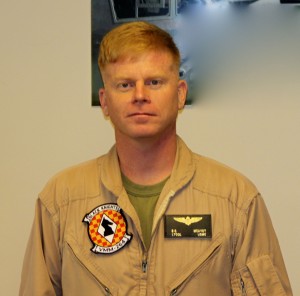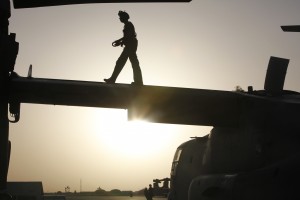2012-09-08 The Osprey has been deployed for five years in combat. Starting in September 2007, the Osprey was deployed to Iraq and then later to Afghanistan. It has several years of at sea experience as well.
The operators – pilots and maintainers – have been part of the “testing” of the aircraft as it has developed under combat conditions. With the new platforms, one reaches a point that the academic testing needs to stop and the real world operational use needs to take the project forward. This was clearly the case with the Osprey.
In a discussion with Lt. Col. Brian McAvoy, the Commanding officer of VMM-264, a good sense of the progress of the Osprey under evolving operational conditions was provided. McAvoy was CH-46 pilot for nine years and then transitioned to the V-22 in 2004. He went on the third Osprey deployment to Iraq in 2009 and then to Afghanistan for the third deployment there in 2011.

Lt. Col. McAvoy provided insight into the differences in how the Marine Corps was able to approach the Osprey and its use in the two deployments as well as to provide insight from flights to participate in the Farnbourgh Air Show in 2006 and then again this year.
In a fundamental way, McAvoy and his experience sheds light on the evolution of the Osprey as a weapon system used by the USMC in operations, both non-combat and combat.
SLD: What were some of the major differences between the flights made in 2006 and 2012 with the Osprey to participate in the Farnbourgh Air Show?
Lt. Col. McAvoy: In 2006, the flight to Farnbourgh was the first transatlantic flight of the Osprey. We flew 2 Ospreys to Farnbourgh and it was challenging. One of the aircraft made it all the way to the U.K. without an issue. The other V-22 experienced “an engine compressor stall” and was forced to make a precautionary landing at a U.S. military base in Iceland. We accomplished the translant mission, but much of what we did was “a first,” so we were learning along the way.”
Fast forward to 2012, with multiple deployments under our belts and over a hundred thousand hours behind the Osprey Community, the transatlantic flight was a totally different experience.
We were required to have 4 Ospreys in Farnbourgh, so we started out with 6 flying from New River to St. John’s Newfoundland, where we stepped off. The aircraft were all configured with three internal fuel tanks to give us about six hours of fuel. This has become standard operating procedure for long-range flights.
In St John’s, we were joined by three KC-130Js; one tanker, one trail maintenance and one back-up. The next morning all aircraft took off without an issue. One hour into the flight, the back-up aircraft (2 MV-22s and 1 KC-130J) returned to St John’s.
The rest of the package took approximately 5,000 lbs of fuel and continued on the 5.5 hour leg to Lajes, Azores. We stayed overnight in Lajes, and the next morning we again departed without issue. Four Ospreys and two KC-130Js flew directly to Farnbourgh from Lajes, Azores in about 6 hours. We had no significant maintenance issues along the way.
SLD: How would describe the difference from 2006 to 2012 at RIAT and Farnbourgh?
Lt. Col. McAvoy: In 2006, it felt like we were a bar act. It was challenging to get there and we were seen as oddities. In 2012, we were flying a plane with years of combat experience. We no longer were a bar act, but war fighters flying and maintaining a key combat capability.
We had a story to tell. We had folks with hundreds of hours of operational experience behind us. It was a proud moment for me as the CO. I was the senior guy and I had no majors; it was all captains, all young guys who really shined in explaining the aircraft to others.
In 2012, it was the young, but very experienced enlisted Marines and officers who told the MV-22 story, and their stories were based on actual combat.
SLD: Let us focus now on the differences from the 3rd deployment to Iraq and the 3rd deployment to Afghanistan, a gap of only two years. How would you describe the differences?
Lt. Col. McAvoy: We were focusing on the basics in Iraq. In my squadron at the time, no one had deployed in combat with this aircraft. Some had deployed with other type model series, but this was the first with the V-22.

In effect, Iraq formed a foundation for follow-on operations and we just gained experience from that deployment and minimized risks in later deployments. We grew together as a team and built a solid foundation during that Iraq deployment.
When we went to Afghanistan last year, we leveraged that foundation.
We were familiar with the aircraft in tough operational conditions. We were able to expand the box exponentially. We moved on from logistic support to doing Named Operations. We have become a high performance assault platform. We are doing large movements day and night into the worst zone, hot zones, places where we know that we are going to have contact with the enemy.
In other words, as the experience grows from the team, we can expand what we can do with the aircraft.
And the young guys with just V-22 experience are pushing the envelope.
During our time in Iraq, we used largely helicopter tactics. In Afghanistan, we were using V-22 tactics.
The military as a whole is now willing to exploit the V-22 capabilities and not just treat it like it was a helicopter.

